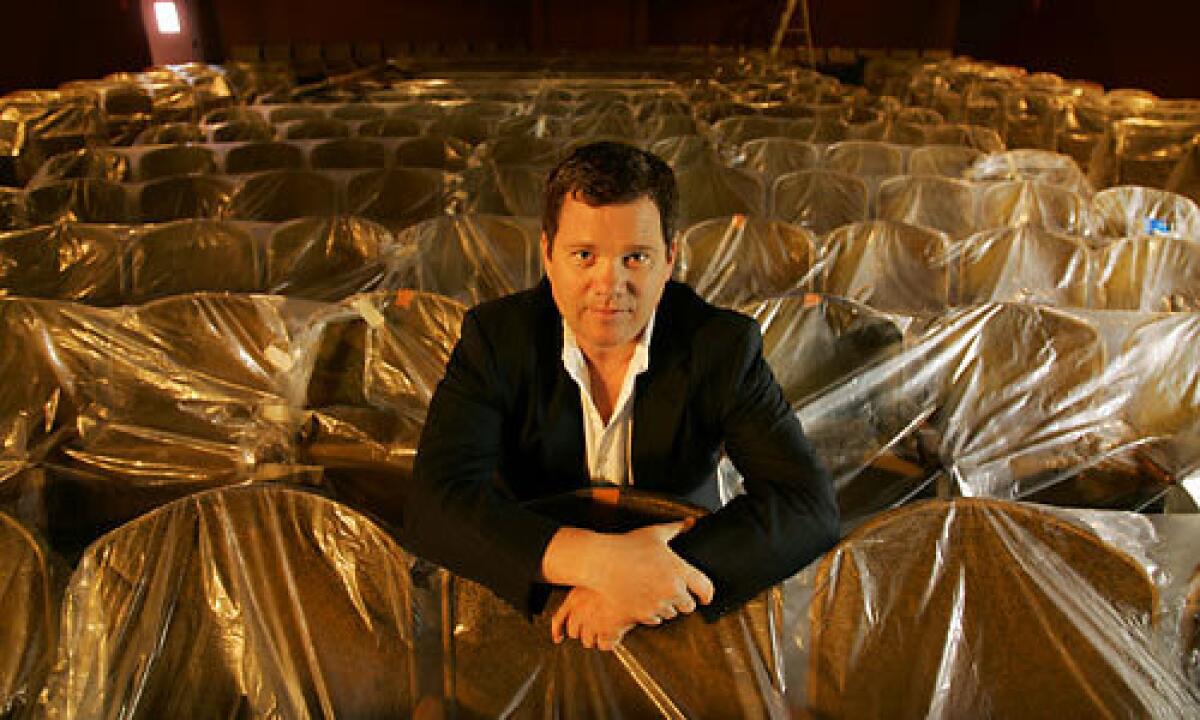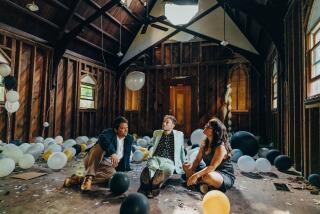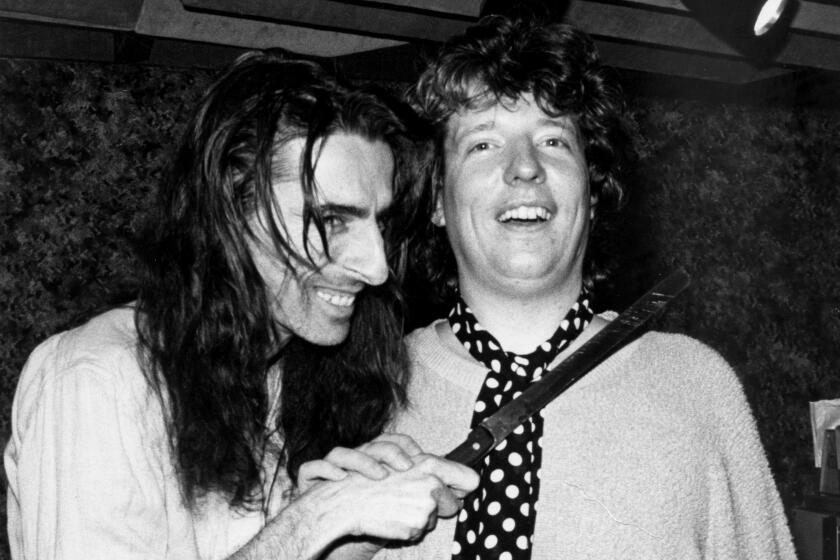Largo gets new lease on life at the old Coronet

- Share via
JON BRION’S last night at Largo was epic. The singer-songwriter’s free-for-all Fridays at the tiny Fairfax Avenue nightclub had been drawing capacity crowds for more than a decade, but his May 2 show was historic: his final turn before owner Mark Flanagan closed up shop to move to a bigger space, the Coronet Theater on La Cienega Boulevard, which is due to open June 2 with a performance by Aimee Mann.
Brion had a bigger-than-usual parade of guest stars, people like E (Mark Oliver Everett) from the Eels, who was pressed into playing drums and singing Prince’s “Raspberry Beret” with Brion, Heartbreakers keyboardist Benmont Tench and bassist Sebastian Steinberg. And there was an extra giddiness to the typical anything-can-happen mood.
“I’m not sad at all,” said Flanagan, 42, while introducing Brion.
For more than a decade, Largo had nurtured his favorite singer-songwriters and comedians -- people who also happen to be some of L.A.’s more eccentric, intelligent and critically acclaimed artists. Flanagan demanded that listeners remain quiet during sets, which kept the focus on the performers. He refused to pander to Hollywood or music-business crowds: You might notice famous, powerful faces in the audience, but Largo was for people who wanted to see the show, not just be seen.
Sure, the club didn’t have a proper dressing room or even a separate restroom for the artists. But for a lot of performers, Largo had a vibe to rival the finest concert halls. And so, during Brion’s last Fairfax show, the unknown future seemed both exciting and unnerving.
“At the new Largo,” E observed wryly, “everyone’s gonna be like, ‘You shoulda been at the old Largo.’ ”
Old-school owner
IN A city where so much live music is booked by big companies such as Live Nation and Goldenvoice, Flanagan has thrived as a hands-on owner-operator, dealing directly with artists. In 1996, he remodeled and reopened the club at 432 N. Fairfax Ave., which he’d originally started with two partners in 1992. The musical fare included such local legends as Brion, Rickie Lee Jones, the late Elliott Smith and Grant-Lee Phillips, plus touring favorites such as Robyn Hitchcock and Neil Finn.
Flanagan also supported such acts as singer-songwriter John Mayer and Jack Black’s comic-rock duo Tenacious D when they were still starting out, and his healthy appreciation for comedy meant that performers including Paul F. Tompkins, Patton Oswalt, Sarah Silverman, Greg Proops and Zach Galifianakis were frequently on the schedule.
“Comedians want to roll with musicians, and vice versa,” says Proops, whose “Greg Proops Chat Show” debuts June 14 at Flanagan’s new joint, dubbed Largo at the Coronet. “That’s been the most fantastic part of Largo -- interfering with each other’s worlds.”
Like most artists, Proops appreciates Flanagan’s famous insistence on absolute silence during performances. “But I hear that, at the new place, we’ll actually be able to see the crowd,” he says with deadpan disappointment. “It was unbelievably, impenetrably dark in that [old] room. I adored that. I never saw the audience for 10 years.”
Largo at the Coronet might or might not be as dark, but it will feel familiar. “It’s going to have what I really want, which is everyone facing the stage and no distractions,” says the Belfast-born Flanagan.
The 60-year-old Coronet has a 280-seat theater with a huge stage and a smaller, 65-seat space called the Little Room, in addition to an upstairs studio that functions as Brion’s artist’s retreat. The area was once used as a dance rehearsal/teaching space by the likes of Betty Grable and Roland Dupree.
Flanagan merged the names to preserve the theater’s legacy while making it his own. The building is painted Largo burgundy, and the club’s old sign hangs in the theater’s brick-paved courtyard. The Largo bar is in the Little Room. More important, the calendar is filled with Largo-associated names: Brion, Tompkins, Silverman, Oswalt, Colin Hay, Nellie McKay and others.
Higher rent and increasingly restrictive parking helped push Flanagan away from Fairfax, but he’d been searching for a “bigger, better” place for years. “What I mean by better is, I don’t want to force people to eat and drink,” he says. “I just want to do shows.”
Largo at the Coronet will offer refreshments -- from beer and wine to coffee and gelato -- but the notorious Fairfax dinner seating is done. “Legally, I had to serve more food than drinks, and it had to be a restaurant,” Flanagan says. He’s happy to be free of those rules, and he expects that while ticket prices will be higher than cover charges at the old place, prices will be comparable, and sometimes lower, without the cost of food and drink.
“The other thing is, we’ve been turning people away for so long now that it’s really frustrating,” he says. For example, shows by New Zealand duo and HBO sensations Flight of the Conchords, Silverman or Brion routinely attracted twice as many people as the 120-capacity room could hold.
Coronet’s charm
THE CORONET was perfect, but getting it wasn’t easy. After learning last October that the new owner planned to tear it down, Flanagan began a campaign of genial harassment that became a lengthy negotiation with the owner of the venue, Hersel Saeidy. By mid-March, he’d secured a 15-year lease and acquired 80 spaces in an adjacent parking garage.
The theater’s wildly varied creative legacy made it seem like an almost magical find. It launched with the 1947 world premiere of Bertolt Brecht’s play “ Galileo,” starring Charles Laughton. A photograph from that era shows a courtyard crowd containing Charlie Chaplin, Jimmy Stewart and Angela Lansbury. Later, film archivist Raymond Rohauer screened Buster Keaton movies there.
More recent theater productions included “Blown Sideways Through Life,” “God Said Ha!” and the long-running “Late Night Catechism,” plus performances by comedian Eddie Izzard.
Flanagan was stunned to discover that his Little Room was the original site of Doug Weston’s Troubadour, where Woody Guthrie and Pete Seeger performed, jazz musician Horace Tapscott played and comedian Lenny Bruce had a residency. “Doug Weston was this sort of character who ran his club, in my opinion, like how Flan does -- the no-talking policy,” says singer-songwriter Tom Brosseau. “It was a real cultural hub for a long time.”
The Coronet, muses Brion, “is interesting, because it’s had a number of different heydays, and it’s still here, which in L.A. is amazing.”
Flanagan is especially excited by the possibilities. The Coronet will house the Largo piano, and he’ll hang some of the old Tiffany lamps in the Little Room. “But I’m not going to try and re-create Largo.”
Indeed, he relishes planning events the Fairfax space couldn’t handle, like having Brion and a band play along to “Punch-Drunk Love,” the 2002 Paul Thomas Anderson film Brion scored, or hosting weeklong music, comedy and film festivals. The film idea is especially apt given that a long-in-the-works Largo documentary by Flanagan and filmmaker Andrew van Baal will premiere at the L.A. Film Festival on June 22.
“The fun thing for me is, there’s enough space to do any number of things,” says Brion. “If I want an orchestra, or just eight people playing, it’s very easily done -- even if I want them all playing marimbas.”
An emotional end
AT THE beginning of Brion’s last night on Fairfax, comedian Dave “Gruber” Allen’s reassurance -- “The spirit and the dream that is Largo will live forever, so don’t freak out” -- seemed unnecessary. It wasn’t a wake. It was a celebra- tion. But later, after Fiona Apple had crooned a devastating “Cry Me a River,” the mood turned melancholy. As 2 a.m. approached, Paul F. Tompkins waxed nostalgic and dropped his wine glass on the stage.
Brion played his last tune, the Kinks’ “Waterloo Sunset,” and said his final thank-you-and-goodnight.
Suddenly, a sense of sacrificing the old -- necessary for bringing in the new -- took hold.
“It’s self-evident how much everyone loves playing this place,” Brion said, his voice pitching high, his face collapsing as he began to weep.
He retreated to the kitchen, and the crowd stood in the dark, clapping. Soon Brion dragged a red-faced, sobbing Flanagan back out with him, and the whole room seemed to be laughing and crying at once.
More to Read
The biggest entertainment stories
Get our big stories about Hollywood, film, television, music, arts, culture and more right in your inbox as soon as they publish.
You may occasionally receive promotional content from the Los Angeles Times.










